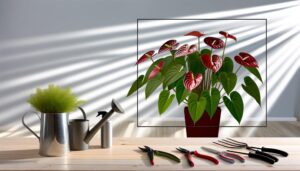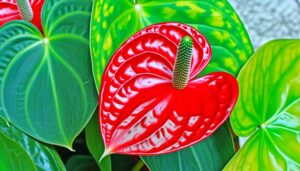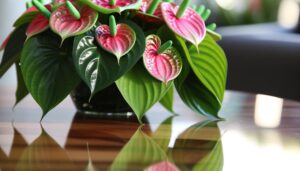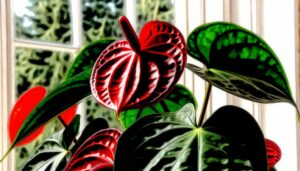What Makes Black Knight Anthurium Unique?
You'll find the Black Knight Anthurium unique for its deep, velvety black spathes caused by anthocyanin pigmentation, which contrast dramatically with its vibrant green foliage. Its distinctive spadix and inflorescence structure showcases intricate botanical adaptations.
The large, heart-shaped laminas, with a glossy and velvety texture, enhance both photosynthesis and structural integrity. This plant's compact, upright growth habit, with tightly clustered stems and spaced leaves, exemplifies resilience and efficient resource allocation.
If you're curious about its other fascinating characteristics, there's much more to explore.

Key Takeaways
- Deep, velvety black spathes due to anthocyanin pigmentation create a striking visual contrast with vibrant green foliage.
- Unique flower structure with a distinctive spadix and velvety petals, enhancing both aesthetic appeal and botanical interest.
- Large, heart-shaped, dark green leaves with a glossy surface and prominent venation for efficient nutrient transport.
- Compact, upright growth habit with tightly clustered stems and resilient, sturdy petioles to minimize drooping.
- Thrives in bright, indirect light and warm, humid conditions, reflecting its tropical understory habitat.
Rare Coloration
The Black Knight Anthurium is renowned for its rare coloration, featuring deep, velvety black spathes that stand out in the plant realm.
You'll notice that these spathes, or modified leaves, exhibit a unique anthocyanin pigmentation, giving them their distinctive black hue.
Unlike other Anthuriums, this species, Anthurium andraeanum, showcases a dramatic contrast between its dark spathes and vibrant, glossy green foliage.
The coloration results from a high concentration of pigments called anthocyanins, which absorb certain wavelengths of light, creating the striking black appearance.
This rare and enchanting color not only intrigues botanists but also makes the Black Knight Anthurium a prized specimen for collectors.
You'll surely appreciate its unparalleled beauty and the scientific wonder it represents.
Unique Flower Structure
You'll notice the Black Knight Anthurium's unique flower structure, characterized by its dark, velvety petals that provide a striking contrast to its surroundings.
The spadix, central to the inflorescence, exhibits a distinctive shape, often elongated and slightly curved.
This combination of features contributes to the plant's exotic and alluring appearance.
Dark, Velvety Petals
Black Knight Anthurium's velvety petals display a remarkably dark shade, distinguished by their unique cellular structure and high concentration of anthocyanins. These pigments give the petals their deep color, absorbing most light wavelengths while reflecting minimal light.
You'll notice the petals' surface feels soft and luxurious, thanks to specialized epidermal cells that create a velvety texture.
The dark pigmentation serves not only aesthetic appeal but also functional roles, such as protecting the plant from excessive light and deterring herbivores. The anthocyanins also act as antioxidants, enhancing the plant's resilience.
When you observe these petals up close, you can appreciate their intricate beauty, a tribute to the marvels of botanical adaptation and survival.
Distinctive Spadix Shape
Marvel at the Black Knight Anthurium's distinctive spadix, which showcases a cylindrical structure that stands prominently amidst the dark, velvety petals. This spadix, often exhibiting a striking contrast in color, is integral to the plant's reproductive anatomy.
Composed of numerous tiny flowers, it serves as the central axis, facilitating pollination. The spadix's texture varies from smooth to slightly rough, enhancing its tactile appeal. You'll find its positioning elevates the visual drama, creating an enchanting focal point.
Botanically, the spadix belongs to the Araceae family, a hallmark of their inflorescence. Its unique morphology not only attracts pollinators but also adds an exotic elegance, making the Black Knight Anthurium an extraordinary specimen to behold and cherish in your collection.
Lush Foliage
The lush foliage of the Black Knight Anthurium is characterized by its large, dark green leaves that exhibit a glossy, almost velvety texture. You'll find these leaves not only striking but also scientifically intriguing due to their unique anatomical features.
Each leaf is heart-shaped with prominent veins, contributing to its robust structure and aesthetic appeal.
- Large, heart-shaped laminas: The expansive leaf blades provide a dramatic visual centerpiece.
- Dark green pigmentation: This coloration is due to high chlorophyll content, essential for photosynthesis.
- Glossy surface: The shiny texture hints at a healthy cuticle layer, protecting against water loss.
- Prominent venation: Visible veins offer structural integrity and efficient nutrient transport.
- Velvety underside: A soft, tactile feel that adds to the plant's allure.
These features make the Black Knight Anthurium a botanical marvel in your collection.
Growth Habit
You'll notice that the Black Knight Anthurium displays a compact, upright growth habit, characterized by tightly clustered stems and consistently spaced leaves. This morphology allows the plant to maintain a neat, sculptural form, perfect for both indoor and conservatory settings.
The stems, or petioles, are sturdy and support the plant's integrity, ensuring minimal drooping. Each leaf emerges in a precise arrangement, promoting excellent photosynthesis and resource allocation.
The internodes are short, contributing to the plant's dense appearance. This growth pattern, known scientifically as a sympodial growth form, is effective for nutrient uptake and moisture retention.
You'll find that this characteristic enhances the Black Knight Anthurium's resilience and longevity, making it a cherished addition to your botanical collection.
Lighting Needs
You'll want to provide your Black Knight Anthurium with bright, indirect light to mimic its natural understory habitat.
It's essential to avoid direct sunlight, which can cause photodamage to its foliage.
Position it near an east or north-facing window for best light conditions, ensuring it thrives indoors.
Optimal Light Conditions
Ensuring that your Black Knight Anthurium receives bright, indirect light is fundamental for its optimal growth and vibrant foliage. This plant thrives in well-lit environments that mimic its tropical origins. Light intensity and duration play a critical role in photosynthesis and overall health.
- Filtered sunlight through sheer curtains or blinds.
- North-facing windows that provide consistent, diffused light.
- Fluorescent grow lights for consistent illumination.
- Shaded spots in a well-lit room to prevent leaf scorch.
- Rotating the plant regularly to guarantee even light distribution.
Avoid Direct Sunlight
Direct sunlight can cause irreparable harm to the delicate leaves of your Black Knight Anthurium, leading to unsightly scorch marks and overall plant stress.
The genus Anthurium, categorized under the Araceae family, thrives in conditions that mimic its native tropical understory habitat. You'll want to provide your Anthurium with bright, indirect light, ensuring it receives sufficient brightness without the harshness of direct solar exposure.
High-intensity light can break down chlorophyll, causing photoinhibition and reducing the plant's photosynthetic efficiency. Shielding your plant from direct rays not only prevents leaf burn but also maintains ideal physiological function.
Use sheer curtains, or position it near a North or East-facing window where it can bask in gentle, filtered light.
Ideal Indoor Placement
To maximize the lighting needs of your Black Knight Anthurium, place it in an area where it receives bright, indirect light for most of the day, such as near a North or East-oriented window. This lighting arrangement mimics the dappled sunlight of its native tropical habitat, preventing leaf burn and promoting peak photosynthesis.
- North-oriented window: Provides consistent, gentle light throughout the day.
- East-oriented window: Guarantees morning sunlight, less intense yet effective.
- Sheer curtains: Scatter harsh rays, creating a soft light environment.
- Next to bright rooms: Benefits from ambient light without direct exposure.
- Under artificial grow lights: Supplements natural light, especially during shorter days.
This placement strategy guarantees your Black Knight Anthurium thrives, maintaining its striking foliage and overall vigor.
Watering Requirements
Watering the Black Knight Anthurium necessitates maintaining consistently moist but not waterlogged soil to support its optimal growth. You'll want to water it when the top inch of soil feels dry to the touch.
Always use room-temperature, filtered water to avoid shocking the plant's roots. It's essential to guarantee proper drainage to prevent root rot. The Black Knight Anthurium thrives in a humid environment, so consider misting its leaves regularly or using a humidity tray.
Over-watering can lead to yellowing leaves and fungal issues, whereas under-watering can cause wilting. By maintaining a balanced watering schedule, you'll secure the plant's vascular tissues remain healthy, promoting lush, vibrant foliage and unique, dark blooms that make this Anthurium truly stand out.
Soil Preferences
The Black Knight Anthurium thrives in a well-ventilated, nutrient-rich soil that mimics the airy, organic composition of its native tropical habitat. You'll want to make sure the soil is both moisture-retentive and well-draining to prevent root rot.
Aim for a mix that includes:
- Orchid bark: providing excellent aeration and replicating natural epiphytic conditions.
- Peat moss: retaining moisture while still offering a light, airy structure.
- Perlite: improving drainage and preventing compacted soil.
- Charcoal: absorbing impurities and keeping the soil fresh.
- Coconut coir: providing organic matter and maintaining a balanced pH level.
These components combine to create an ideal environment for the Black Knight Anthurium, promoting strong growth and lush foliage.
Temperature Tolerance
While ensuring ideal soil conditions is essential for the Black Knight Anthurium, maintaining the right temperature range is equally significant for its growth and overall health. You should aim for a consistent temperature between 65°F to 75°F (18°C to 24°C).
This species thrives in warm, humid conditions, mimicking its native tropical environment. Avoid exposing it to temperatures below 55°F (13°C) as it can cause irreversible damage to the plant's cellular structure. If your home's temperature fluctuates, consider using a greenhouse or a temperature-controlled indoor environment.
Propagation Techniques
Effective propagation techniques for the Black Knight Anthurium involve both stem cuttings and division, ensuring genetic consistency and robust growth.
When you're ready to propagate, follow these precise steps:
- Stem Cuttings: Select a healthy stem with at least two nodes. Use a sterilized blade to make a clean cut just below a node.
- Rooting Medium: Prepare a moist, well-draining medium such as a mix of perlite and sphagnum moss.
- Division: Carefully separate the root clumps during repotting, ensuring each division has roots and foliage.
- Humidity: Maintain high humidity levels around the cuttings or divisions using a humidity dome or plastic bag.
- Indirect Light: Place the propagated sections in a location with bright, indirect sunlight to encourage root development.
Conclusion
In your pursuit to cultivate the distinct Black Knight Anthurium, keep in mind that its uncommon, dark-colored blooms aren't only visually captivating but scientifically intriguing. Picture this: the plant's nearly-black spathes are a product of high anthocyanin levels, making it a genuine botanical treasure.
With its abundant foliage and particular requirements—such as well-draining soil and indirect sunlight—you're not simply cultivating a plant; you're fostering a marvel of nature's intricate craftsmanship.
Adequate care guarantees your Black Knight flourishes, a proof of your horticultural expertise.






